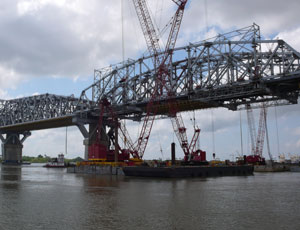Contractors on the $453-million superstructure erection portion of the $1.2-billion Huey P. Long Bridge widening project in New Orleans broke their own record when they lifted and skidded into place a 528-ft. long, 2,758-ton steel truss in 8.5 hours April 9.


The lift was the heaviest of three performed by MTI, a joint venture of Massman Construction Co., Kansas City, Mo., Traylor Bros. Inc., Evansville, Ind. and IHI Inc., New York City, as part of a span-by-span erection sequence designed to minimize disruptions to rail, maritime and automotive traffic, and reduce risk to the public and contractor during construction.
“When you think about lifting 3,000 tons of steel 13 stories in the air over a moving river and aligning so you can get those bolts into tight spaces, and doing it time after time, that’s exceptional,” says Robert Kollmar, chief engineering officer of New Orleans Public Belt Railroad, which owns the bridge. “You couldn’t ask for more.”
Yet MTI delivered more by: vertically lifting the truss 102 ft in 4.5 hours; skidding it laterally 13 ft in 4 hours; installing pins in 2.5 hours; opening the Mississippi River’s main navigation channel to marine traffic 2 hours ahead of schedule; disrupting rail traffic only 4 hours instead of the 8 scheduled; and opening the bridge to automotive traffic 13 hours ahead of schedule.
“This lift went smoother and quicker because all systems performed well due to corrections and tweaks made from lessons learned during the first two lifts,” says Steve Underwood, MTI project manager.
All three lifts required 48-hour bridge closures to automobile traffic, as well as shorter time-frame closures for rail and marine traffic. However, MTI delivered early on all three lifts, reducing closure times.
Each of the lifts required simultaneously lifting two separate halves of the truss, rather than hoisting a complete assembly, to build around the existing bridge and expand the bridge deck.
The third truss lift was similar to the first one in June 2010 in that it required both a vertical lift and a 13 ft lateral move to bypass the 22-ft by-22 ft by 30-ft-tall temporary lifting towers that were installed on bridge piers to support the four, 900-ton strand jacks that made the lift. However, the first truss that was lifted last June was 538 ft. long, weighed 2,650 tons and took 8 for the vertical lift and 4 hours to make the lateral skid. The second lift, in Nov. 2010, was 503 ft long, weighed 2,550 tons and took about 7 hours to make the vertical lift. No lateral skidding was required on the second lift.
This final lift went faster for a few reasons. “The other two times, there were problems with one of the four cylinders (in the hydraulic jacks) not stroking as much as the others and MTI would have to stop to stroke it to catch up with the others,” says Steve Spohrer, deputy director of construction for Louisiana TIMED Managers, a joint venture of GEC Inc., PB Americas Inc., and THE LPA GROUP INC., which is overseeing the project for the Louisiana Dept. of Transportation and Development. “This time, all four jacks were running at exactly the same pace for the whole lift. They were never more than a 10th of an inch out of level.”
On the last lift, the contractor also lost use of a hydraulic jack for about an hour, says John Brestin, project manager for consulting engineer, HNTB Corp., Kansas City, which was hired by MTI to devise the span-by-span sequence. “I think the jacks were running a little faster this time because it’s not quite as hot [as last June],” Brestin says.
The strand jacks were lifting at about 23 ft per hour, as opposed to an average of 17 ft per hour on the previous two lifts, Underwood says. Additionally, “this lift [102 ft. vertical] was about 10 to 15 ft less than the previous lifts due to a higher river elevation and this span being at a lower elevation,” he says.
“The third time is a charm,” Spohrer says. “We’re just as proud as we can be that it went so smooth and so well. This is further proof positive that DOTD has assembled a fantastic team to do this work.”
By 4 p.m. Sunday, April 10, MTI had connected hornbeams and secondary members and opened the Huey P. Long Bridge to motor traffic. The contractor lowered the 850-ton stability frames that supported the truss halves and kept them plumb during erection, back onto the barge assembly and transported them shore side.
Underwood says the hardest part of the job lies ahead, “tying up all the details on the end.” MTI is still tasked with hanging all the secondary members in the recently-attached span, painting all of the connections, and demobilizing the job. By the end of the project, MTI will have installed 17,500 tons of structural steel and 750,000 new bolts.
MTI’s contract is scheduled for completion April 15, 2012. The entire bridge widening will be complete in 2013.

